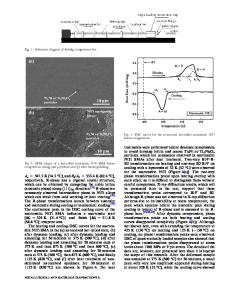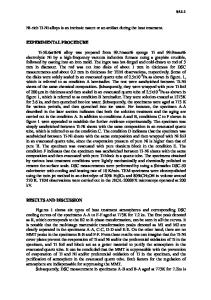Effect of W Contents on Martensitic Transformation and Shape Memory Effect in Co-Al-W Alloys
- PDF / 2,526,204 Bytes
- 9 Pages / 593.972 x 792 pts Page_size
- 11 Downloads / 372 Views
RODUCTION
CO-AL alloys undergoing face-centered cubic (fcc) Ð hexagonal close-packed (hcp) martensitic transformation, as one kind of new shape memory alloys, have aroused interest of scholars in past decades for their combined advantages of shape memory effect (SME)[1–7] and ferromagnetism.[2–4] In the Co-Al alloys, both the parent phase and martensitic phase are ferromagnetism.[2–4] In contrast, both of them are paramagnetic in the conventional Ni-Ti-based[8,9] and Fe-Mn-Si-based shape memory alloys.[10–12] This combination of the SME and ferromagnetism enables the Co-Al alloys to be used in industry and civilian fields where the ferromagnetism is required. In addition, the Co-Al alloys are also considered as attractive candidates for high-temperature shape memory alloys because their reverse transformation temperature of the martensite can be adjusted to above 473 K (200 °C) by compositions.[1,4] Recently, Wen et al. clarified that the SME in the Co-Al alloys also resulted from the stress-induced fcc Ð hcp martensitic transformation and its reverse transformation,[5–7,13,14] as the conventional Fe-Mn-Si-based shape memory alloys undergoing fcc Ð hcp martensitic transformation do.[15–18] To obtain a good SME, the macroscopic shape deformation should be assumed by the stress-induced hcp martensitic transformation rather than the unrecovered slip deformation.[5–7] Accordingly,
X. YANG, B.N. QIAN, H.B. PENG, B.J. WU, and Y.H. WEN are with the School of Manufacturing Science and Engineering, Sichuan University, Chengdu, 610065, People’s Republic of China. Contact e-mails: [email protected]; [email protected] Manuscript submitted 11 September, 2017.
METALLURGICAL AND MATERIALS TRANSACTIONS A
it can be expected that the SME will be improved by suppressing the slip deformation and promoting the stress-induced hcp martensitic transformation. Because W element can not only solution strengthen the parent phase but also lower the stacking fault energy in the Co-based alloys,[19–25] the addition of W will suppress the slip deformation and promote the stress-induced hcp martensitic transformation. Thus, the addition of W is expected to improve the SME in the Co-Al alloys. However, the studies by Ando et al. showed that the SME when deformed at room temperature (RT) in the (Co90Al10)100-xWx (x = 0, 2.2, 4.0, 6.2 at. pct) alloys decreased rapidly with increasing the W content.[4] In contrast, our recent results revealed that although the addition of 5.4 wt pct W also seriously deteriorated the SME in a solution-treated Co-6.6Al alloy when deformed at RT, it significantly improved the SME when deformed in liquid nitrogen.[5] When deformed at RT by about 2.6 pct, the SME was only 16 pct in the solution-treated Co-6.5Al-5.4W alloy, being about half of that in the solution-treated Co-6.6Al alloy. However, it increased to 65 pct when deformed in liquid nitrogen, being 20 pct higher than that in the solution-treated Co-6.6Al alloy. Especially, a high recovery strain of about 3.1 pct was obtained in the Co-6.5Al-5.4W alloy, which was
Data Loading...











